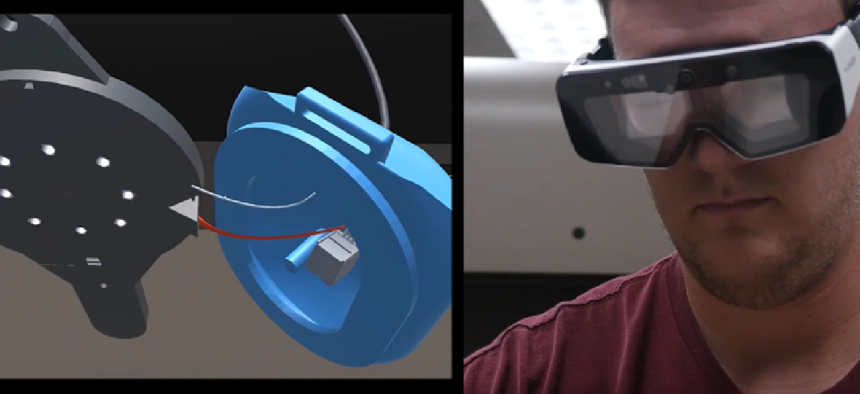LA taps augmented reality for specialized repairs


Connecting state and local government leaders
AR googles and home-grown software not only help technicians make repairs faster and more accurately, they may even help attract tech talent to Los Angeles.
As workers in Los Angeles with specialized knowledge retire, the city is using augmented reality to transfer knowledge to younger employees.
Goggles from AR firm Daqri have reduced the time it takes to train someone to repair the $350 headsets firefighters use to communicate from 90 minutes to 30, and sometimes a few as five. That’s because in addition to seeing actual reality, trainees wearing the goggles can view additional information, such as notes on how to do the repairs.
A type of virtual reality, AR “allows virtual images to be superimposed over the real-world environment, providing users with nearly unlimited interaction with data, information, and even fun,” according to DigitalGov, and government agencies at all levels are taking notice of it. In February 2018, the Defense Advanced Research Projects Agency awarded engineers at Columbia University a $4.7 million grant to improve AR glasses, and in October 2017 the General Services Administration launched the Federal Virtual/Augmented Reality Community, a collaborative hub for researching use cases. AR has a place on many lists of top IT trends for 2019.
Before LA adopted the AR goggles, its 105 fire stations spread across the city’s 469 square miles had to send broken headsets to the C. Erwin Piper Technical Center, where just one worker, who was getting ready to retire, knew how to fix them.
Joyce Edson, LA’s deputy CIO within the city’s Information Technology Agency, was looking for a way to apply AR and saw an opportunity with the headset repairs. An unpaid intern with interest in AR worked with ITA Applications Programmer Jeremy Stout for about eight weeks setting up 3D models of the firefighters' headsets. Using open source software from Unity and two AR helmets that Daqri donated to the city to use for research and development (the goggles came later), the city had a solution to test at a very low cost.
Users of the goggles can see the broken headset, pull it apart and get directions on how to fix it -- all within their field of vision. Edson likened it to Pokemon Go, in which players see the real world on their smartphone screens with Pokemon characters superimposed.
As workers repair the headsets, the goggles give them access to reference materials in the upper corner of their view. “They can also ask for the guy who really knows how to do this [repair] to sign in," Edson said. "He can see what they see, and he can annotate in their field of vision what it is that they’re missing, and then they can go off and fix it. … It’s been a really good training tool.”
The goggles connect to a power unit that’s about the size of a smartphone, so workers can be mobile as they use it, not tethered to a computer. For that reason, the city is looking to use AR for the next generation of workers who will climb and repair the city’s large microwave towers, Edson said.
Since using the pro bono helmets, the city has bought three pairs of goggles for a little less than $5,000 apiece. Edson is looking for less-expensive options and said the Unity code the city wrote is transferrable between AR viewers. Still, with more than 1,500 headsets in use by firefighters, AR “can save the city literally tens of thousands of dollars every year,” CIO Ted Ross said in a March 2018 video about the technology.
The biggest savings is in the time, Edson said -- both to train workers to fix the headsets and to actually fix them. “It also enabled us to have a little bit better quality in this because rather than having the people rifle through papers to figure out what they’re doing and figure it out on their own, they had electronic access to [documentation] as they were doing it, and if they got stuck, they [could contact] the remote supervisor,” she said. “They could actually ask somebody to come in, even if they weren’t physically at their site, to take a look at what they were seeing and they could get the help right there.”
With nearly 40 percent of LA city workers eligible to retire in the next year, Edson hopes the program will help attract new talent to LA, which the Center for Digital Government put at the top of its list of cities using technology to tackle problems and innovate for three years in a row.
“We’re starting to look at it for more of an interactive experience,” too, she said. For instance, the Department of Recreation and Parks is building a smart park to showcase innovations and technology, so Edson wants to use AR to promote that, potentially incorporating gaming and cryptocurrency elements down the line.
“We’re thinking about all these different things, and as the stars align and we’re able to do it, then we’ll do it,” said Edson, adding that she has six to 12 ideas on the drawing board. One that she expects to bring online in 2019 is LACIE, or the Los Angeles City Interactive Experience, which will be a chatbot with an AR component.
“We want to bring her to life with location-based AR, kind of in the vein of Pokemon,” Edson said.




